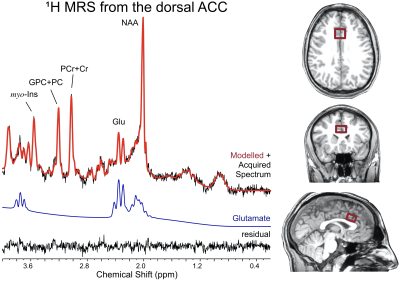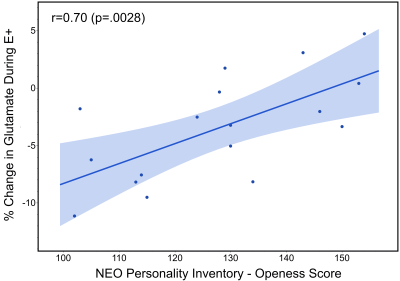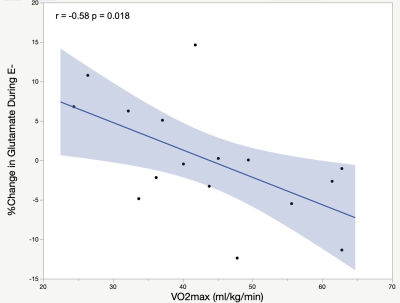2921
Excitability of the Glutamatergic Neurotransmission in the Anterior Cingulate During Appraisal of Emotional Stimuli
Paul R Burghardt1, Dalal Khatib1, Andrew Neff1, Katherine Nowak1, Katlin Chappelle1, and Jeffrey Stanley1
1Wayne State University, Detroit, MI, United States
1Wayne State University, Detroit, MI, United States
Synopsis
Personality and fitness impact emotional regulation, however the neurobiological mechanisms underlying these relationships are poorly understood. dACC glutamate modulation was quantified during appraisal of emotional images using ¹H fMRS. Additionally, aerobic fitness and trait personality were assessed in participants. The dACC glutamate was lower during positive images compared to neutral images, which was associated with trait openness. Glutamate levels during appraisal of negative emotional images did not differ from neutral images, but was negatively associated with aerobic fitness. These results shed light on the mechanisms that modulate the impact of trait personality and fitness on ACC response during emotional regulation.
Introduction
Poor stress coping is a skillset that impacts individual health and wellness and is known to be a precipitating factor for disease. Individual psychological traits, like neuroticism, influence appraisal of emotional stimuli and coping strategies. In contrast, trait openness has been linked to improved stress regulation1. The anterior cingulate cortex (ACC) is a brain region involved in modulating emotion2 and has been shown to increase in volume following an aerobic training program in older adults3 and regular exercisers have greater improvement in mood4. The impact of aerobic fitness and personality trait on the neurobiological response to appraising emotional stimuli as measured by ¹H fMRS5 has not been well described and could be useful for personalizing treatment interventions for individuals. To better understand these relationships, we utilized in vivo 1H fMRS to discern distinct shifts in the excitatory and inhibitory (E/I) synaptic balance5 related to emotional valence by characterizing glutamate modulation in the dorsal ACC (dACC) during the appraisal of pictures of different valence. Further, we investigated whether these neural responses related to personality trait and aerobic fitness level.Methods
Personality trait and fitness status were measured on twenty healthy adult volunteers (14 males and 6 females; mean age: 31.3±9.3 years; age range: 20 to 51 years) using the NEO Personality Inventory and maximal oxygen consumption (VO2max), respectively. On a separate morning visit (9:30am-11:30am), the ¹H fMRS using a picture appraisal task was conducted on a 3T Siemens Verio system with a 32-channel volume head-coil. Specifically, the fMRS task included 3 blocks containing different valanced pictures from the Nencki Affective Picture System6 [i.e., a block of each with primarily neutral (En), positive (E+) and negative (E-) valenced pictures]. The block order (48 pictures in each; 4s per picture; 3:12min per block) was randomized and interspersed with a 16s rest epoch. Following a structural T1-weighted scan (MPRAGE), a single-voxel (1.5x2.0x1.5cm3 or 3.4cm3) was prescribed midline in the dACC using the AVP approach7, followed by B0-field shimming using FASTESTMAP. During the task, 38 consecutive ¹H MRS measurements were acquired every 16s (PRESS with OVS and VAPOR, TE=23ms, TR=2.67s, 6 averages/measurements, 12 measurements/block, 2048 data points). In each block, the first two measurements were removed, and the remaining 10 measurements were phased and shift corrected prior to averaging and quantification using LCModel (v6.3) (Figure 1). A repeated measure generalized estimating equations (GEE) approach with block condition (En, E+ and E-) as the independent variable was used to model glutamate changes across conditions and post-hoc differences were evaluated using least square means (SAS GENMOD; SAS Institute Inc). Changes in NAA, PCr+Cr, GPC+PC and myo-inositol were also assessed.Results
The main block condition term was only significant for glutamate (χ2= 6.26, p=.044) and not for NAA, PCr+Cr, GPC+PC or myo-inositol. Post-hoc analyses demonstrated a significant lower glutamate level during the E+ condition compared to the En condition (Z value= 2.62, p=.0088; Figure 2). A non-significant trend existed for glutamate during the E+ condition being lower than E- (Z = 1.86, p=.062). Higher trait scores for openness were associated with a greater glutamate response during appraisal of E+ (r=0.70, p=0.0028; Figure 3). VO2max exhibited a negative association with dACC glutamate modulation during the E- response (r=-0.58, p=0.018; Figure 4).Discussion
These results demonstrate, for the first time, distinct shifts in the E/I balance as measured by changes in glutamate using ¹H fMRS across the appraisal of emotional pictures. Specifically, glutamate levels were lower during the appraisal of positive emotional valence compared to the glutamate during neutral pictures reflecting a shift in the excitatory/inhibitory balance towards decreased excitation (or increased inhibition). Higher trait levels of openness were associated with relatively higher glutamate during appraisal of positive images which may speak to trait psychological differences in the assessment of emotional stimuli and the level of excitation in the ACC. Additionally, greater aerobic fitness was negatively associated with relatively lower glutamate relative to the En glutamate during the appraisal of negative images, indicating that aerobic fitness may be linked to decreased excitation (or increased inhibition) in the ACC when engaging negative emotional stimuli. Given previous work showing regular exercise and openness are involved in improving mood and handling stress1,5, our results lay the neurobiological framework for understanding the mechanisms involved in personality type and fitness level on emotional responses.Acknowledgements
The Lycaki-Young Funds from the State of Michigan. Brain and Behavior Research Foundation.References
- Williams PG, Rau HK, Cribbet MR, Gunn HE. Openness to experience and stress regulation. Journal of Research in Personality. 2009 Oct 1;43(5):777-84.
- Etkin A, Egner T, Kalisch R. Emotional processing in anterior cingulate and medial prefrontal cortex. Trends in cognitive sciences. 2011 Feb 1;15(2):85-93.
- Colcombe SJ, Erickson KI, Scalf PE, Kim JS, Prakash R, McAuley E, Elavsky S, Marquez DX, Hu L, Kramer AF. Aerobic exercise training increases brain volume in aging humans. The Journals of Gerontology Series A: Biological Sciences and Medical Sciences. 2006 Nov 1;61(11):1166-70.
- Hoffman MD, Hoffman DR. Exercisers achieve greater acute exercise-induced mood enhancement than nonexercisers. Archives of physical medicine and rehabilitation. 2008 Feb 1;89(2):358-63.
- Stanley JA, Raz N. Functional Magnetic Resonance Spectroscopy: The "New" MRS for Cognitive Neuroscience and Psychiatry Research. Frontiers in psychiatry. 2018;9:76.
- Marchewka A., Żurawski Ł., Jednoróg K., Grabowska A. (2014) The Nencki Affective Picture System (NAPS): introduction to a novel, standardized, wide-range, high-quality, realistic picture database. Behavior Research Methods, 46(2), 596–610.
- Woodcock EA, Arshad M, Khatib D, Stanley JA. Automated Voxel Placement: A Linux-based Suite of Tools for Accurate and Reliable Single Voxel Coregistration. J Neuroimaging Psychiatry Neurol 2018;3(1):1-8.
Figures

Figure 1: A typical ¹H MRS spectrum from the dACC
after combining 10 measurements (6 averages/measurement). The ¹H MRS spectrum
in black is superimposed on the LCModel fitted spectrum in red. Below includes
the glutamate signal (Glu) in blue and the residual of the fitting in grey. The
placement of the single-voxel in the dACC is depicted on the right.

Figure 2: Mean change in glutamate response during viewing
of E+ (positive images) and E- (negative images) compared to En (neutral
images).

Figure 3: Association between trait openness and glutamate
response during appraisal of E+.

Figure 4: Association between maximal oxygen consumption
(VO2max) and glutamate response during appraisal of E-.